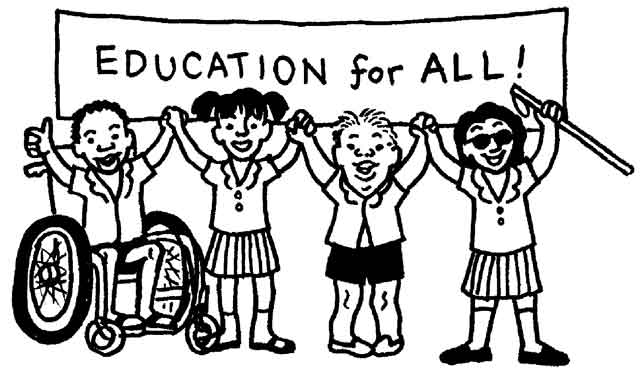Your progress
0%
Here are some of the key ideas about CBR and inclusive education.
Use your mouse or keyboard to expand each of the headings below
These terms can be confusing and tend to mean different things in different cultures and contexts. In general, you can use the following definitions.
The links between poverty, disability and education suggest that a community-based development approach is essential.
“Lack of adequate education remains the key risk factor for poverty and exclusion for all children, both with and without disabilities. For children with disabilities, however, the risk of poverty due to lack of education may be even higher than for children without disabilities. Children with disabilities who are excluded from education are virtually certain to be long-term, lifelong poor” (Jonsson T, Wiman R. Education, poverty and disability in developing countries. In: Poverty reduction sourcebook. Washington, DC, World Bank, 2001).
Poor people face difficulties in educating their children with disabilities when fees are required to access education. Even when education is promoted as free, families are often obliged to make additional up-front payments for schoolbooks, uniforms, transport or assistive devices. As a result, children with disabilities from poor families continue not to be educated, and the cycle of poverty continues.
Inclusive education focuses on changing the system to fit the student, rather than changing the student to fit the system.
It is “a process of addressing and responding to the diversity of needs of all learners through increasing participation in learning, cultures and communities, and reducing exclusion within and from education” (http://unesdoc.unesco.org/images/0014/001402/140224e.pdf).
Inclusive education:
Facilitating access to inclusive education

A school may have an accessible building and teachers who are trained to work with all types of children, but children with disabilities may still be excluded. They may be hidden in back rooms at home, the family may lack support, and they may need assistive devices and medical rehabilitation to make the most of educational opportunities. CBR can address all these issues and liaise between the education, health and social sectors and with disabled people’s organizations. CBR personnel may need to engage in several rounds of discussions with parents to shift their beliefs about the benefits of educating their disabled child, especially if the child is a girl or the parents are not educated themselves.
CBR should include home-based education and sign-language groups for deaf children and adults.
Special education is not only for people with disabilities. “Special education” is a broad term that refers to the provision of several types of support to help children access education, including:
Extra assistance
Adapted programmes
Specialized learning environments
Specialized equipment
Specialized materials or methods, including Braille, audio devices and assistive devices, including smartphones and tablets and sign language
The term “special educational needs” is used to refer to the learning requirements of any child who might have difficulties with learning.
The term “special” is not helpful for the promotion of inclusive education. The term “special-needs child“ is vague and is often used to refer to any child with a disability, regardless of whether they have learning difficulties. It is important to remember that children learn in different ways, and may find learning easy or difficult at different times in their lives. To say that children with disabilities have “special” learning needs is not helpful, because it is not specific and labels them. Children without a disability can also experience difficulties in learning, and can be excluded and marginalized within educational settings. With good teaching techniques, essential resources and an inclusive environment, all children can learn. Dropping the label “special needs” and describing the learning requirements of each child is a step forward in creating an inclusive approach that serves to ensure learning for all children in relation to their capacity.
CBR personnel need to be aware of gender issues in relation to education.
Girls may miss out on educational opportunities if required to care for a family member with a disability
In some situations, boys may miss out on schooling because of the pressure to earn money to support their family
The mother or other female relative of a person with a disability may need to take on a teaching role, often increasing her already heavy workload
Families and communities often do not prioritize education for girls and women with disabilities, who therefore experience double discrimination
Girls with disabilities are more likely to drop out of school because of a lack of suitable toilet facilities and safe environment
The role of fathers is important and is often ignored – a father can be a good role-model and support education
Read about the challenges that a girl in India faced in her goal to attain an education.


In Hazaribagh, northern India, RupaKumari cares for a whole family because her mother has mental illness, her father is dead, and she has a younger brother and sister. To avoid missing out on her education, Rupa takes her very young sister to school with her, and even though class sizes are very big and the teachers complained, Rupa managed to convince them that, for her to continue to study, she must bring her younger sibling with her.